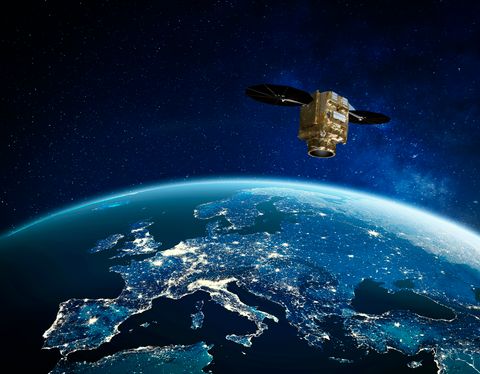Behind the scenes of the first metal part to be 3D-printed aboard the ISS

After seven months in space, the first metal 3D part was printed onboard the International Space Station (ISS), 400 kilometres above the Earth. How did the team do it?
In January 2024, the European Space Agency’s (ESA) metal 3D printer, the first to be installed on a space station, successfully arrived on board the ISS. Built by Airbus and its partners*, the printer’s objective is to demonstrate the feasibility of metallic part production in microgravity, opening the way to new on-orbit manufacturing capabilities.
Once the printer had been installed on board the ISS’ Columbus module in May this year, and the printer door hermetically sealed by ESA astronaut Andreas Mogensen, the printing process began. Print operations were overseen at the French space agency CNES, from the control centre for ISS payloads. Two operators from Airbus and CNES ensured that the process ran smoothly.
Printing starts
The team started with commissioning tests, an essential phase in which the 3D printer’s subsystems are tested to ensure they work together: the stainless steel deposition system, the laser, the wire feed. It was also necessary to check the coordination of the printer’s moving plates, securing its ability to deposit metal with a predetermined trajectory.
Then, the printing process could begin, as it does in conventional desktop 3D printers, by depositing melted material onto a moving plate in the desired shape, to build up a part layer by layer. Here, instead of plastic, we melt a stainless steel wire with a high-power laser.
Deposit of the first stainless steel letter S © Airbus/ESA - 2024
A final test was needed to validate this commissioning phase: the deposition of a stainless steel letter S. “Successfully printing the S validated what we call ‘2D’,” says metal 3D Lead Engineer Anthony Lecossais. “Next, we had to move to 3D, which means depositing several layers on top of each other. It was no bed of roses, and we had to deal with some uncertainties. The ISS is a place like no other, with a high level of safety. We also have a complex operations scenario to ensure that we can reliably control and monitor the payload remotely via the ISS telecommunication links.”
After a few adjustments with the help of the project’s partner AddUp, the layers could be linked together. “As each layer is controlled, we were able to run sequences of two to three minutes, then wait for feedback from the CNES operator before running the next sequence to check the print performance and make any corrections,” Lecossais explains.
Getting better every day
Of all the parameters of 3D printing, getting the layer height right needs the most attention. The height is measured before a calibration command is sent to adjust the height of the next layer. And there are over 200 layers to print. “It is meticulous work, we learned every day, by scanning every printed layer and with all the data from the payload. This helped us to continuously adapt,” Lecossais says.
By mid-July, and 55 layers later, half of the first sample had been printed, marking the start of a ‘cruise phase’ when the printing rate accelerated thanks to optimisation sources both on the ground and on board the ISS. For example, following a noise requirement analysis, the printing time was increased from 3.5 to 4.5 hours per day.
Video of the first 3D metal part printed on space station © Airbus/ESA - 2024
By early August 2024, the first sample was ready for an ISS astronaut to retrieve. The metal 3D printer is housed in a sealed box that acts like a safe to maintain the right atmosphere inside the printer with a very low level of oxygen and to ensure onboard safety. During the printing phase, the oxygen in this box was replaced with nitrogen to protect the ISS and its crew from the risks associated with using a high-powered laser to get to the metal's melting point of over 1,200°C. Swapping oxygen for nitrogen also prevented the metal from oxidising.
The final step was to return the atmosphere inside the printer to normal, in order to open the sealed box without depressurisation. On 21 August, astronauts Sunita Williams and Jeanette Epps retrieved the first sample from the metal 3D printer.

An enabler for in-space manufacturing technology
“This first sample will allow the ESA to characterise the effect of the microgravity environment on the metal 3D printing process, by comparing the mechanical properties of this part produced in space, with the same part produced in our laboratory in Toulouse. It also tested the practicalities of operation,” says Lecossais.
The other three specimens to be printed will demonstrate different properties of the metal. The four parts will be analysed on the ground at ESTEC, the European Astronaut Centre and the Technical University of Denmark, after return from the ISS.
“One of the major objectives of this technology demonstrator is to gather as much data as possible of the effects of microgravity on the printing performance. We are very pleased to have achieved a successful print, right first time!”, Lecossais concludes. “It will help to advance technologies for in-space manufacturing needs, from tooling and repairs needs to additive construction, opening up new possibilities for future space exploration missions.”

*The metal 3D printer was developed by a consortium comprising Airbus Defence and Space, AddUp, Cranfield University and Highftech Engineering, under a programme of and funded by the European Space Agency (ESA). The views expressed herein can in no way be taken to reflect the official opinion of the ESA.


